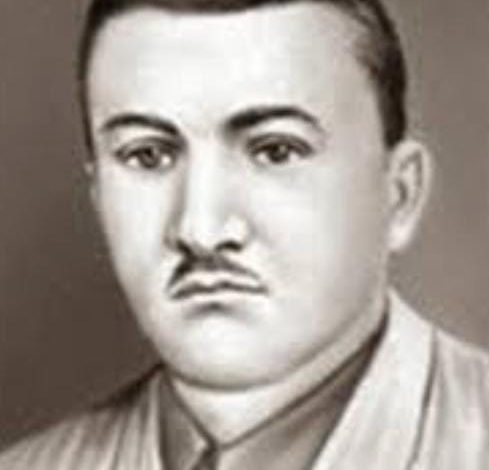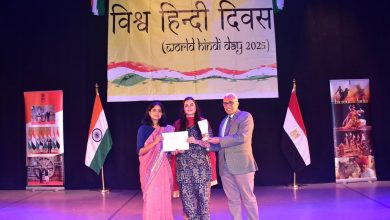Title: Lessons from the Genius of the Pen: Uzbek Writer Abdullah Qodiriy

By: Fatma Badawy
In Uzbekistan, special attention is given to preserving the memory of the most talented Uzbek figures who spoke about their homeland. One significant event in this context is the commemoration of the 130th anniversary of the birth of Abdullah Qodiriy, one of the greatest masters of artistic expression in the twentieth century. The writer portrayed dozens of heroes who depicted the lives of ordinary people finding themselves in difficult situations and knowing how to emerge from them with dignity.
Each character from his works represents a separate memory for every reader, while the wisdom of the author himself is placed in the mouths of the characters.
When discussing Qodiriy’s works, it seems important to arm ourselves with a methodology for analyzing fine arts, theater, music, cinema, and television. It’s also worth remembering that much has been invented at the intersection of sciences, in the process of convergence and interaction between different arts. A talented novel and its cinematic interpretation, the mutual enrichment of classical poetry and elegant dynamic miniatures, music (including ethnography), the system of poetry, and oral folk art. Researching in this direction would be an interesting and important step in penetrating the creative laboratory of the epic painter.
“If I were an artist, I would create an image of Rano,” this is reflected by Abdullah Qodiriy in the novel “Scorpion from the Altar.” – “I want the color of the rose.” Using warm colors, the master of the pen (as well as the artist holding the brush) expresses his attitude towards the central character – Rano, with her extreme beauty and delicate nature. This shade symbolizes love and loyalty. Following the writer’s lead, we imagine early the colors of joy and tender feelings. Collaborating with Qodiriy, we add details to the imaginary picture. Frame after frame, a silhouette and expressive strokes emerge. And in the end, a close-up of a girl captivates us with the charm of youth, “with a smile of rosy lips.”
All of this is cinematic, reminiscent of the best examples of cinematic drama, of which we have few.
The author presents dramatic scenes in his novels with stunning expression. Like a palette of colors, the artistic arsenal of the prose writer is enriched on the desk and becomes more vibrant. The images are expressive: spring mountains, hills, flower-covered valleys. The sound component is also rich: the chirping of birds, the song of a farmer leading a team of bulls on fertile land. Immersed in his thoughts, Atabek gradually surrenders to the charm of spring. Only the upcoming farewell song from afar brought him back to his previous state: despair, sadness, and tears overwhelmed him again. Tears flowed down his cheeks.
The writer considered all sensory channels of perception by the individual (in the excerpt analyzed by the reader), describing the feel, “singing,” tangible image, and smell. In its midst lies initially the slow and relaxed Atabek. And after a moment – admiration for the beauty of spring, dreams, and shedding tears. And let us specifically emphasize: the author also takes into account the sense of smell that arises from deep reading of the text of the wonderful book: “the smell of flowers can only make a person happy,” “Atabek cannot help but inhale the smell,” flowing above the steppes, listening to the bird’s song.
The dynamic spring landscapes, in which the image of the main character constantly appears, are also interesting because they are described according to the interview method: the contrast between the simple mood of the character and the main optimistic, colorful, and flourishing environment. Later, this artistic technique, proven scientifically by Einstein, led to the enrichment of the audiovisual arts.
Abdullah Qodiriy did not write the screenplay. But unlike many writers, he treated cinema with respect. The director-actor Yuldashev Aghzamov and the writer Zinat Fatkhullina – contemporaries of our hero – spoke about the desire of Nabi Janiyev to film the movie “Past Days” with Suleiman Khodzaev in the lead role. And this director, screenwriter, and actor (by the way, highly respected by Abdullah Qodiriy!) was already talented in those years and received high film education.
The appearance of a new feature film in those days was a major event. The halls were filled with spectators. Newspapers wrote in detail about the films, although the films were silent, in black and white. The writer Qodiriy responded. And he expressed his attitude in writing for the first steps of Uzbek cinema.
We have done little research. We studied this article carefully, originally published in the newspaper “Kizil Uzbekistan” on April 28, 1927. And during the research, we reached the following conclusion: Abdullah, nicknamed one of the best films in the silent film period, watched “Son of the Raven” before it was shown on state screens.
According to the government film fund, located in the town of Bely Stolby near Moscow, the film was shown to viewers on May 18 of the same year. Qodiriy put pen to paper in March.
By comparing the texts of newspaper articles with statements by the author, who worked this time as a journalist, we clarified the day of writing the review, which, in terms of coverage of cinematic and semi-cinematic events and presentation style, complied with the laws of the journalistic genre.
The journalist wrote: “In yesterday’s issue of Pravda Vostoka, Dzurabayev misled European readers.”
We found this material, which the author called “In the Shadow of Uzbek Life” and got acquainted with it. “Yesterday’s issue” mentioned by Abdullah Qodiriy is dated March 28, 1927. This means that the article about “Son of the Raven” was written on March 29. And in these spring days, the Qodiriy family annually moves to the summer garden, located near the center of Samarkand Darvoza Mukhalla.
Thus, the article was written and submitted to the editors during the enthusiastic work on the novel “Scorpion from the Altar,” which was published shortly after – in 1929. The document testifies to the author’s interest in current issues. Cinematography evolves. The cinematic shots and scenes are compared with the phenomena of daily life, reflecting the behavior of the protagonist in difficult circumstances and their mental state. The comparative analysis of literary and screen characters is interesting. Qodiriy does not tolerate the youth of Sharq Yulduzi and their lack of experience (this is the name of the film studio located in the complex of Sheikhantakhur architecture).
We detailed the short work of Abdullah Qodiriy as well because the issues raised by the writer in the newspaper material have not lost their relevance today. Educating creative employees (screenwriters, actors, and performance artists primarily, as Qodiriy wrote), searching for national forms of expression on screen, professional and demanding but cautious attitude towards filmmakers and their works – these most important issues are now given special attention. Abdullah Qodiriy seems to anticipate the aggravation of the problem in the future.
It is customary not to delay the break or intermission between chapters or performances. Actions are required. Understanding the depths of the writer’s work and the media environment surrounding him.
So far, changes are measured after the
lesson given by the writer for decades. Much has been created during this time. But repeatedly, we will turn to his prose and journalism. You can and should take lessons in professionalism (in all areas, especially in the creative field), courage, perseverance, and love of life, because these values have not lost their importance today.
Hamidullo Akbarov, Doctor of Linguistics, Asta



